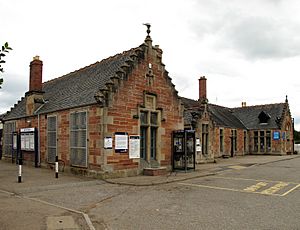Dingwall railway station facts for kids
Quick facts for kids
|
|
|---|---|

The platforms at Dingwall station, looking south
|
|
| Location | Dingwall, Highland Scotland |
| Coordinates | 57°35′39″N 4°25′20″W / 57.5942°N 4.4222°W |
| Platforms | 2 |
| Other information | |
| Station code | DIN |
| History | |
| Original company | Inverness and Ross-shire Railway |
| Pre-grouping | Highland Railway |
| Post-grouping | LMS |
| Key dates | |
| 11 June 1862 | Opened |
| Traffic | |
| Passengers (2017/18) | |
| Passengers (2018/19) | |
| Passengers (2019/20) | |
| Passengers (2020/21) | |
| Passengers (2021/22) | |
|
Listed Building – Category B
|
|
| Designated | 25 February 1986 |
| Reference no. | LB24514 |
Dingwall railway station is a train station in Dingwall, Scotland. It's an important stop for trains going north on the Far North Line and west on the Kyle of Lochalsh Line. The station is managed by ScotRail, which is also the main train company that uses it. Dingwall station is about 18 miles (29 km) from Inverness. It's the starting point for the Kyle of Lochalsh Line.
Contents
History of Dingwall Station
Dingwall station first opened on 11 June 1862. It was built by a company called the Inverness and Ross-shire Railway (I&RR). This company's first train line ran from Inverness to Dingwall. A year later, the line was extended to Invergordon.
Over time, the railway companies changed. The I&RR joined with another company, and they became known as the Highland Railway (HR) in 1865. The station buildings you see today were built by the Highland Railway in 1886.
Later, in 1923, the Highland Railway became part of a much larger company called the London Midland and Scottish Railway (LMSR).
Trains from Dingwall used to go to places like Wick, Thurso, and Kyle of Lochalsh. Between 1885 and 1946, there was even a special branch line that went to Strathpeffer.
The Highland Railway also built a small shed near the station for steam trains. This shed was used until the early 1960s when steam trains were no longer common.
How Trains Are Controlled
The station used to have two special buildings called signal boxes. These helped control the trains and the tracks. However, in 1985, a new system called Radio Electronic Token Block (RETB) was introduced. This system uses radio signals to tell train drivers when it's safe to go.
At first, the RETB system for the Far North Line was controlled from Dingwall station. But in 1988, the control moved to a new center in Inverness. Now, train drivers heading north use a special button on the platform to choose which track they need. Trains coming south automatically set the correct track when they approach the station.
The station buildings and platforms are considered important historical structures. They are listed as "Category B" by Historic Scotland.
The Station Sign
The town's name in Scottish Gaelic is Inbhir Pheofharain. For a while, the station sign had a small mistake in the Gaelic spelling. But don't worry, it was corrected in 2014!
Past Incidents
In 1897, a train leaving Dingwall had a small problem. Some of its coaches rolled back down a hill because the connection between them broke. They stopped safely before reaching the main junction.
On 22 January 2010, a train (a Class 158 Express Sprinter unit) derailed at Dingwall. Luckily, no one was seriously hurt, but one passenger went to the hospital just to be safe.
Station Facilities
Dingwall station has many useful things for passengers. Both platforms have benches where you can sit and "help points" if you need assistance. Most of the main facilities are on Platform 1. Here you'll find a waiting area, a toilet for disabled people, a ticket office, and even a small bar.
Outside, there's a car park and places to park your bike. Platform 2 also has a waiting room and a shelter from the weather. It's easy to get to both platforms without using steps. New digital screens have been added to both platforms. These screens show when the next three trains are coming and give important safety messages.
Platform Layout
The station has two platforms and a "passing loop." A passing loop is an extra section of track that allows trains going in opposite directions to pass each other, or for a faster train to overtake a slower one. The loop at Dingwall is about 32 chains (640 meters) long.
Platform 1, which is for trains heading north, is long enough for trains with eight coaches. Platform 2, for trains heading south, can hold trains with up to ten coaches.
Train Services
Dingwall is a very important station on the Far North Line, so every train stops here.
On weekdays and Saturdays, you can catch:
- 7 trains heading north (4 to Wick via Thurso, 1 to Invergordon, 1 to Ardgay, and 1 to Tain).
- 4 trains heading west to Kyle of Lochalsh.
- 14 trains heading south to Inverness.
On Sundays, there are fewer trains:
- 5 trains heading north (1 to Wick, 3 to Tain, 1 to Invergordon).
- 1 train heading west to Kyle of Lochalsh.
- 6 trains heading south to Inverness.
| Preceding station | Following station | |||
|---|---|---|---|---|
| Conon Bridge or Muir of Ord |
ScotRail Kyle of Lochalsh Line |
Garve | ||
| ScotRail Far North Line |
Alness or Invergordon or Terminus |
|||
| Historical railways | ||||
| Conon Line and station open |
Highland Railway |
Foulis Line open; station closed |
||
| Highland Railway Dingwall and Skye Railway |
Achterneed Line open; station closed |
|||
| Disused railways | ||||
| Terminus | Highland Railway D&SR Strathpeffer Branch |
Strathpeffer Line and station closed |
||



